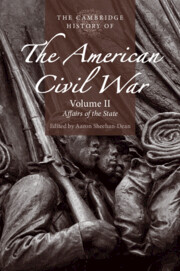Book contents
- The Cambridge History of the American Civil War
- The Cambridge History of the American Civil War
- The Cambridge History of the American Civil War
- Copyright page
- Contents
- Contributors to Volume II
- Note on the Text
- Part I Causes
- Part II Managing the War
- Part III The Global War
- Part IV Politics
- Index
- References
Part II - Managing the War
Published online by Cambridge University Press: 11 October 2019
- The Cambridge History of the American Civil War
- The Cambridge History of the American Civil War
- The Cambridge History of the American Civil War
- Copyright page
- Contents
- Contributors to Volume II
- Note on the Text
- Part I Causes
- Part II Managing the War
- Part III The Global War
- Part IV Politics
- Index
- References
Summary
The current method of differentiating levels of war did not exist during the Civil War. Most Civil War leaders only looked at the prospective battle (tactical issues), not at how each individual engagement fitted into a campaign (the operational level of war), and how this related to the nation’s military strategy (the methods for prosecuting it). Some tout a supposed awareness of the teachings of Baron Antoine-Henri Jomini’s Art of War among Civil War leaders, but all that can be proven is this work’s influence upon certain generals such as the Union’s Henry Wager Halleck and the Confederacy’s Pierre G. T. Beauregard.
- Type
- Chapter
- Information
- The Cambridge History of the American Civil War , pp. 63 - 316Publisher: Cambridge University PressPrint publication year: 2019



